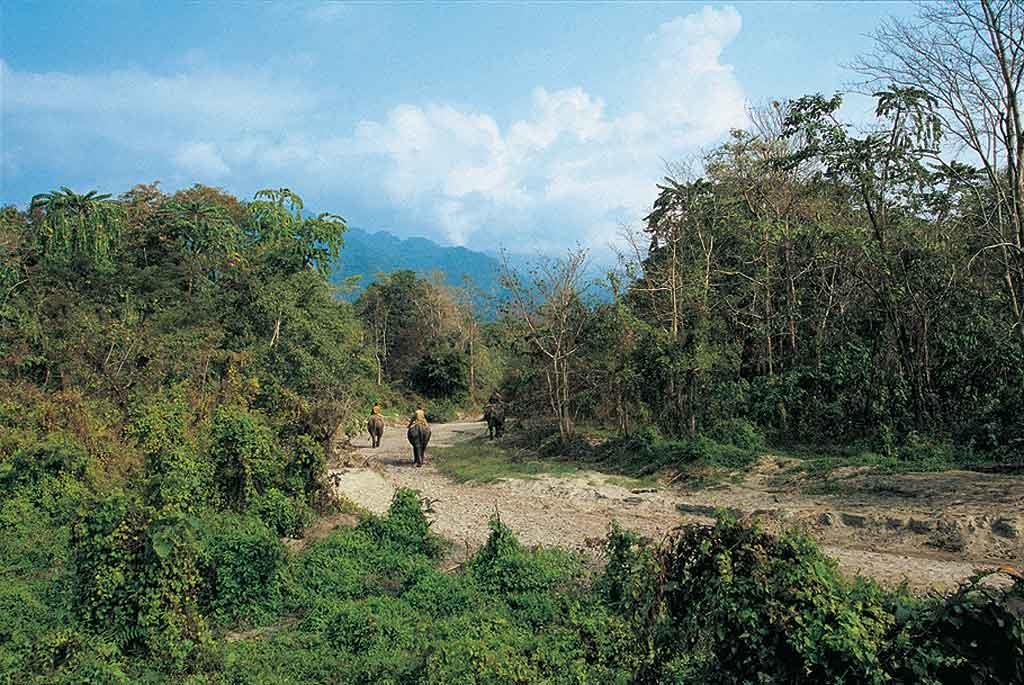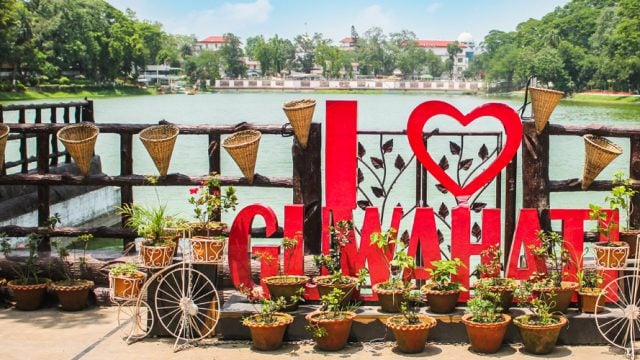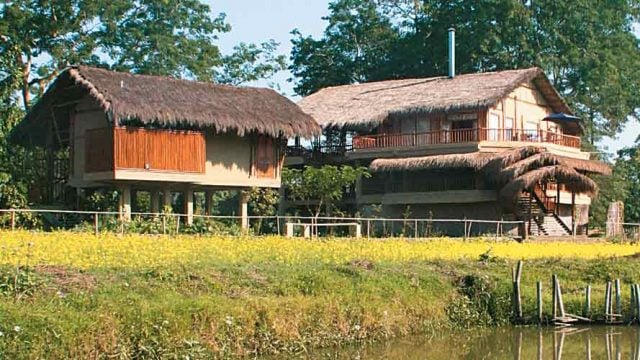When stuff gets in Pramila’s way, she just steps on it until it isn’t in her way
In the wake of Pramila’s enormous butt walks Narmada, bearing me high on her back from where I can see the hairs on her bulbous head and her trunk stripping off leafy snacks. Both elephants move easily through mossy undergrowth, where creepers and stranglers grow like sheets, through groves of oxi trees with great dark leaves, across grassland, along dry stony riverbeds, over steep inclines; and all the while the world is lightening slowly, emerging from pre-dawn grey into glorious dew-washed colour.
We’re on safari around Mathanguri, deep inside the park, where the government maintains its Inspection Bungalow at a spectacular vantage point overlooking the rushing river and the cloudy Bhutanese hills into which the park extends as the Royal Manas Park. Beyond a bend in the river, tantalisingly out of reach, lies the summer palace of the King of Bhutan, reputedly haunted by troops of rare golden langur. The bungalow’s glassed-in dining room makes a spiffing place to devour the packed breakfast our guides have laid out. For the true jungle lover, Mathanguri is the place to stay at Manas. If you can put up with decrepitude inside, the great outdoors will pamper you constantly. At dusk, cormorants glide along the sun-pinked water and I watch a male and female sambhar walk hesitantly out of the forest on delicate hooves to drink at the river.
Just outside the gates to Manas are our own simple but comfortable rooms at the Bansbari Lodge, which stands like a lonely sentinel outside a park which finally, after years of hard luck, is seeing a renewed influx of tourists. The staff has a long list of woes relating to the park management, and rightly so.
Assam has its special problems. Floods, insurgency, tribalism, neglect. Manas National Park and its creatures — of which several, including the golden langur, the red panda and the hispid hare, feature in the IUCN Red List — have endured them all. For fifteen years it has put up with Bodo and ULFA insurgents in the jungles, cockily using the Mathanguri bungalows as headquarters; army operations to flush them out; rampant poaching that has more or less wiped out the one-horned rhino population (though two were spotted last November). Today the security situation is better, but after the long trauma of violent politics, Manas now suffers from insensitive tourism and poor management.
Driving here on our first day, we passed a steady stream of vehicles filled with revellers heading home. It turns out that local and regional tourists have bullied officials into letting them picnic inside the park, loud and unsightly affairs flagged at their conclusion by pools of litter. Standing amid paper plates and plastic, cigarette butts and human excrement, the World Heritage Site status suddenly looks bizarre. The rules which govern other national parks simply do not work on the ground at Manas.
This has its benefits. We can spend all day in the park, for one, rather than stick to timings. And we can also end up, after dark, following animal spoors along the dry bed of the Songrang stream — on foot. Manas is a tiger reserve, home to sixty-four predators at last count, and I happen to have recurring nightmares about this kind of thing, but it’s irresistible. So, with my body on high alert, I follow sambhar and wild elephant and jungle cat footprints in the sand in pitch blackness, stiff with excitement and fear.
At night, on foot, is the best time to appreciate the pathos of modern-day man in the wild. No camouflaging skin, no defensive claws or teeth, no stealth (we sound, for all our tiptoeing, like the proverbial herd of elephants), no swiftness, eyes too blind and nose too dull to either find food or guard against becoming food. Just a bunch of bipedal snacks who might as well carry a sign reading Grub’s Up.
We’re accompanied by an armed forest guard — this, at least, is as per the rules — whose venerable old rifle is intended mostly as a noisy deterrent for the odd elephant. Ahead of me, at a fallen tree lying across the stream bed, he suddenly stops and points. Peering into the darkness with my heart thumping, I see him unshoulder his weapon and finger the trigger. The young tracker switches on the searchlight and focuses its powerful beam upon the glittering eyes of a startled wild water buffalo — an animal far more dangerous than the stripy gentleman of the forest, in that it has a very bad temper backed up by metre-long horns that taper to mean twinkly points. The buffalo shuffles its bulk around and paws the ground uncertainly, but after a lot of pausing and staring, edges into the trees.
That’s when it strikes me that we’re the only living things in the forest who aren’t quietly minding our own business. Every other creature finds food, raises its young and dies as peacefully and self-effacingly as possible. Only we stomp about the forest, sticking searchlights and cameras into everybody’s face, getting cheap thrills out of imagining that every clawed and fanged thing out there has nothing better to do than stalk us. And suddenly the dark seems a lot less threatening. After a half hour of walking and shining the light into the trees in the vain hope of an answering glitter, we drive back to the lodge.
Only one twenty-two-kilometre jeep safari route from the gate to Mathanguri is open; the others fell into disrepair during the park’s dark days. You’d think it might get boring, but each one of our six journeys is as different as the weather and light and time of day. The first was in the wake of a thundershower, when thick dawn mist made paintings of the silk cotton trees and their soft, blood-red blossoms carpeting the road. On another the sun was a peach-pink ball behind a veil of cloud; one afternoon was golden; another twilight made monkeys of our eyes. Now, at night, the jeep lights bewitch the forest into a C.S. Lewis novel. The trees rise in odd, twisty shapes from the road, branches leaning out and over and blooming upwards in starbursts, everything wavy and crooked and curly. It’s suddenly clear that in a jungle there is no such thing as a straight edge. Along the way we pick up oranges that have fallen onto the road from Tata trucks that carry them from Bhutan through what is effectively an international trade route through the park. Great oranges, though.
And then we come upon a dhole, a wild dog, lying by the side of the road. A crude steel trap has bitten deep into its right hind foot, probably a few days ago, judging by the gangrene that has spread up to the animal’s shoulder. The dhole has tried to bite its own leg off. It is moments away from death, breathing with the last shreds of its life force, but its eyes open wide when we take the trap off. We take the animal and the trap to the Park Ranger’s office, where officials nod approvingly because, they say, dhole eat up all the deer. The fact that the trap could have snared any creature, or that it’s there at all, doesn’t come up for discussion. It’s on that note that we have to leave Manas, heartbroken as the forest itself, wondering if anyone has the political will to save what must be one of India’s most beautiful national parks.
The Information
Getting there
There are direct flights to Guwahati from Kolkata (from Rs 2,000), Delhi (from Rs 3,500), and Mumbai (from Rs 4,000). Manas NP is a 176km/4hr drive from Guwahati. The nearestrailhead is Barpeta Road (30km; from Delhi Rs 1,776 on 2A, Kolkata Rs 1,144, Mumbai Rs 2,007).
Tour Operators
Help Tourism (0353-2433683, helptourism.com) can organise a six-day trip (3N each at Manas and Kaziranga) for Rs 59,000 per person. Or write to the Manas Maozigendri Ecotourism Society (1N/2D safari from Rs 3,256 for a group of four; 9957844136,manasmaozi.com), which runs the Manas Jungle Camp.
Guwahati
Manas National Park
wildlife
Leave a Reply
You must be logged in to post a comment.





